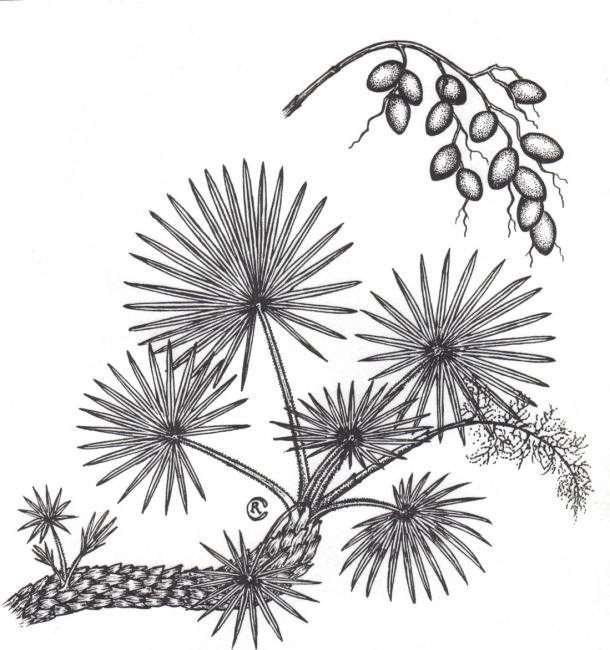
Sabal for the prostate
The sawtooth palm (Sabal) grows in the marshy areas along the southeast coast of the United States. The plant has a characteristic rhizome, which rises from the ground on one side and forms a short trunk from which green-whitish, lobber/sawn leaves sprouting. By the American Indians, the berries of the plant were used in case of bladder problems. In modern phytotherapy, it has been shown that extracts are effective in benign prostatic hypertrophy.Botany and Chemistry of Serenoa repens or Sabal serrulata
The sawtooth palm produces dark purple to black, in groups growing berries that ripen between October and December. These ripe, partially dried berries form the starting material for the preparation of medicinal extracts. The berries are rich in free fatty acids (oleic, lauric, myristic, palmitic, linoleic, caproic, caprylic, capriic, stearic and linolenic) and their esters (ethyl esters and triglycerides). Plant sterols such as β-sitosterol, stigmasterol and daucosterol are also considered as important ingredients. Furthermore, polysaccharides, flavonoids, volatile oils and anthranilic acid have been identified in the berries.Traditional use
The Indians used the berries of the sawtooth palm already for urogenital diseases. They attributed to the berries a positive effect on the functioning of the testis and on irritations of the mucous membrane. The first colo-nists used sabal as fodder and noticed that the cattle gained a shiny coat and became thicker. Around 1870, research was conducted on the medical properties of sabal for the first time. A very diverse number of effects have been reported, including sti-mulating food lust, increasing milk delivery by mammary gland tissue, reducing menstrual symptoms and irritations to the uterus and ovaries, as well as alleviating complaints due to prostate enlargement and inflammation of the penis. The berries of the saw-tooth palm were included in 1906 as a medicine in the United States Pharmacopoeia and in 1926 in the National Formulary. However, this official status was deprived of sabal again because the active ingredients could not be isolated and phytotherapists generally fell into disuse after the emergence of synthetic medicines. However, in recent years, a renewed interest in the use of sabal has been seen, and several clinical studies have also been conducted.Effectiveness and safety of sabal in prostatic hypertrophy (BPH)
The (partially) dried sabalberries, in whole or in pulverized form, are processed into commercially available phytotherapeutics and marketed in the form of tea preparations, tinctures, capsules and dry extracts. Liposterolic oil extracts obtained with n-hexane, 90 -96% alcohol or supercritical carbon dioxide and standardised to a free fatty acid content of 70 -95% have been frequently clinically tested for effectiveness in the treatment of mictile disorders and mild to moderate complaints due to BPH.In most clinical studies, a daily dose of 320 mg extract (single dose or 160 mg twice daily) was compared with placebo, in some cases also with active control (including 5-α reductase inhibitor finasteride and selective α1 receptor blockers such as alfuzosin and tamsulosin). These studies were generally short-lived, ranging from one to three months, but sometimes longer (six months to two years). Meta-analyses show that sabal treatment compared to placebo treatment leads to a general improvement in symptoms, both when urination complaints were quantified with the International Prostate Symptom Score (IPSS) and when (subjective) reporting by patients and attending physician happened. Sabal also showed a significant improvement in various urodynamic parameters — maximum urine flow, mean flow rate and residual volume of urine in the bladder and the number of times to urinate at night. In a number of studies, a beneficial effect on the quality of life was also observed. However, treatment with sabal does not affect the size of the prostate. Compared to regularly used medicinal products, sabal appears to be comparable in efficacy.
Sources and references
https://sites.google.com/site/kruidwis/planten-van-a-tot-z/serenoa-dwergpalmAmerican palm ethnomedicine: a meta-analysis.Sosnowska J, Balslev H.J Ethnobiol Ethnomed. 2009 Dec 24; 5:43. Review.
Serenoa Repens: Does It have Any Role in the Management of Androgenetic Alopecia?Murugusundram S.J Cutan Aesthet Surg. 2009 Jan; 2 (1) :31-2.
#sabal #prostaat #BPH
Sharing = earning
1,000,000 views = € 1,000
100,000 views = € 100
10,000 views = € 10
1,000 views = € 1
500 views = € 0.50
250 views = € 0.25
100 views = € 0.10
50 views = € 0.05
25 views = € 0.025
10 views = € 0.01
And much more
- Comments (0)
- Recommended
- Milestones
No comments yet
Here are your recommended items...
Here are your milestones...




